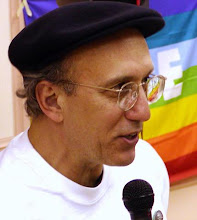Bruce Gagnon on the need to stop U.S. weaponization of space and missile defense
Monday, October 26th, 2009
Listen Now Download the show by right-clicking the link.
Bruce Gagnon is the Coordinator of the Global Network Against Weapons & Nuclear Power in Space, and has worked on space issues for 27 years. He was the organizer of the Cancel Cassini Campaign (the Cassini Campaign was a project that launched 72 pounds of plutonium into space in 1997) which drew enormous support and media coverage around the world. In this compelling interview, Gagnon discusses with Dr. Caldicott the current situation surrounding space weaponisation and missile defense.
Near the start of this episode, Gagnon and Dr. Caldicott look at the Cassini mission, and a worst-case scenario of the satellite scattering plutonium over the Earth. Dr. Caldicott explains the terrible toxicity of Plutonium-238. The program then focuses on the United States’s weaponization of space and missile defense. Gagnon mentions which U.S. corporations are profiting from weaponizing space (using billions of U.S. taxpayer dollars), and the arrogant agenda of the U.S. to dominate and fight wars from space. He talks about the problem of space debris, U.S. plans for cyberwarfare, and which weapons are being installed in space. He describes the war-games scenarios the U.S. military now engages in, and the major role of military satellites.
Dr. Caldicott brings up the topic of drones, the pilotless planes the U.S. now uses to kill people by remote control. Read the Oct. 19 article Report: Drone Strikes Increased Dramatically Under Obama. Gagnon says that people can watch videos about drones on the Space4Peace website (go here).
The Pentagon, Gagnon says, boasts that space weaponization / missile defense is the largest industrial project in the history of planet Earth, as described in Gagnon’s 2009 article The Space Arms Race and the NASA Scam. Gagnon notes that all NASA projects are now dual use - military and civilian. Dr. Caldicott asks Gagnon for his assessment of President Obama’s actions in the arena of missile defense and nuclear disarmament, and Gagnon says Obama has been disappointing on missile defense. They discuss Defense Secretary Robert Gates’s September opinion piece in The New York Times, A Better Missile Defense for a Safer Europe. Gagnon refers to recent remarks by the Czech government about missile defense, as explained in Former Czech Foreign Minister Talks About Missile Defense, Belarus, And Russia.
Dr. Caldicott underscores how U.S. missile defense installations are really targeted at Russia, and related to never-abandoned U.S. plans to fight nuclear war with the former Soviet Union. Gagnon discusses the focus of U.S. military strategy on controlling natural resources and pipelines. He mentions April remarks by Mikhail Gorbachev, alluding to the U.S., about how the development of military space technology, and the aggressive encirclement of another country with weapons, will prevent nuclear disarmament from occurring. Read Gorbachev’s October 5 address to the United Nations, Resetting the Nuclear Disarmament Agenda.
The U.S. is developing military space technologies, Dr. Caldicott emphasizes, to completely dominate the planet. She asks Gagnon about the psychology of the people developing space weapons, and he gives his interpretations for their behavior. Gagnon stresses that the public should not be intimidated by weapons scientists, and should become very vocal about demanding an end to weapons programs and conversion of tax dollars for both human needs and solving the environmental crisis. After the conclusion of the interview with Gagnon, Dr. Caldicott reads from the chapter on the ozone layer in her latest book, the fully revised edition of If You Love This Planet, published in September by WW Norton Company. If You Love This Planet, the book, covers all major environmental issues in depth and is a perfect complement to this radio program.
For more background on the U.S. military’s plans for space, see Vision for 2020, a document published by the U.S. Space Command and the blueprint for U.S. domination of the Earth from space. The document calls for “dominating the space dimension of military operations to protect U.S. interests and investment” and it focuses on the concept of “full spectrum dominance,” which is now the aim of the U.S. military. Compare the above to the Outer Space Treaty [Declaration of Legal Principles Governing the Activities of States in the Exploration and Use of Outer Space], on a United Nations web page.
Also see the U.S. military’s Air Force Space Command: Strategic Master Plan, FY06 and Beyond. This document declares that for the U.S., “maintaining space superiority is an essential prerequisite for success in modern warfare…Simply, we must be able to quickly subjugate any space capability any adversary can field while maintaining our own.” Read The Next 50 Years of U.S. Space Leadership, a 2007 speech by Lockheed Martin CEO Robert J. Stevens in which he states that “[t]here is no substitute or alternative to military dominance in space.” Lockheed Martin is the world’s largest weapons maker. Its enormous influence over U.S. politicians is covered in detail in Dr. Caldicott’s 2004 book The New Nuclear Danger: George W. Bush’s Military-Industrial Complex. For much more on the destructive potential of the U.S. weaponization of space, space war and missile defense, be sure to read Dr. Caldicott and Craig Eisendrath’s 2007 book, War in Heaven. This thorough book, which relies partly on Bruce Gagnon’s groundbreaking research, is “[a] revelatory look at the U.S. government’s plan to put weapons in outer space, by two bestselling experts.”







 If you’ve ever wondered how the body is affected by cell phone radiation, you won’t want to miss this show.
If you’ve ever wondered how the body is affected by cell phone radiation, you won’t want to miss this show. 
